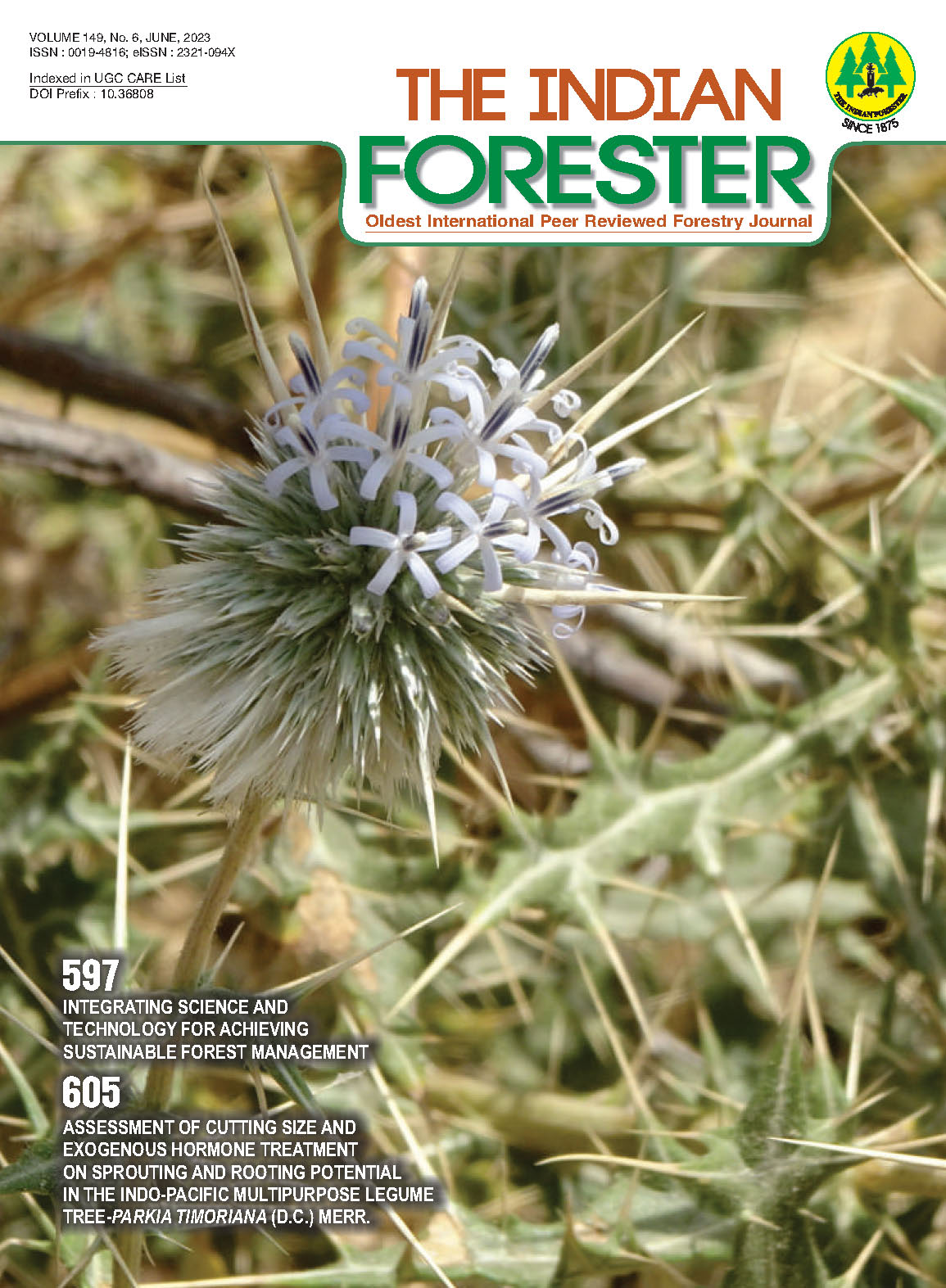Integrating Science and Technology for Achieving Sustainable Forest Management S.P.Vasudeva
DOI:
https://doi.org/10.36808/if/2023/v149i6/169542Keywords:
Artificial Intelligence (AI), Geographical Information System (GIS), Global Positioning System (GPS), Internet of Things (IoT), Remote Sensing (RS), Science and Technology (S&T), Sustainable Forest Management (SFM).Abstract
Science and technology can play a significant role in bringing forest sustainability by integrating its various applications into forest management practices. Remote sensing, GIS, GPS, tissue culture, biotechnology, emerging technologies and precision forestry are some of the innovations that can bring such a positive change. These scientific and technological innovations and interventions can and are fastening forest management systems but have to be integrated into forest policy and operational systems to achieve sustainable forest management.References
Asif M.J., Ali A., Mazhar M.Z., T anvir A., Zia B., Anmbreen I., Anjum M.Z. and Mahr. M.S. (2020). Effect of different pre-treatments on seed germination of Prosopis juliflora and Dalbergia sissoo: a step towards mutation breeding. J. For. Sci., 66: 80–87.
Bajaj Y .P .S. (1991). Biotechnology in agriculture and forestry 16: Trees III. Springer Verlag, Berlin, Germany
Banu T .P ., Borlea G.F . and Banu C. (2016). The use of drones in forestry . Journal of Environmental Science and Engineering, 5: 557-562 doi:10.17265/2162-5263/2016.11.007
Bhatia A.K., Singh Samanpreet, Dutt Som, Chaudhary N. and Sharma V . (2020). Precision Forestry. Just Agriculture, 1 (4) : 185-190.
Chalupa V . (1985). Somatic embryogenesis and plantlet regeneration from cultured immature and mature embryos of Picea abies (L.) Karst. Communications of the Institute for Forestry of the Czech Republic, 14: 57–63.
Chaudhary H. and Kelly G.O.' (2018). Precision forestry: A revolution in woods. McKinsey and Company.
Doty S.L., James C.A., Moore A.L., Vaizovic A., Singleton G.L., Ma C., Khan Z., Xin G., Kang J.W., Park Y ., Meilan R., Strauss S.H., Wilkerson J., Farinand F . and Strand S.E. (2007). Enhanced phytoremediation of volatile environmental pollutants with transgenic trees. Proceedings of National Academy of Sciences, USA. 104: 16816-16821.
Dou X.Y . Yang and Luo J. (2018). Estimating forest carbon fluxes using machine learning techniques based on eddy covariance measurements. Sustainability, 10: 203.
Falk T ., Herndon N., Grau E., Buehler S., Richter P ., Zaman S., Baker E.M., Ramnath R., Ficklin S., Staton M., Feltus F .A., Jung S., Main D. and Wegrzyn J.L. (2018). Growing and cultivating the forest genomics database, TreeGenes. Database 1-11. doi:10.1093/database/bay084.
Fillatti J.J., Sellmer J., McCown B., Haissig B. and Comai L. ( 1987) . Agro bacterium- mediated transformation and regeneration of Populus. Molecular and General Genetics, 206: 192–199.
Grant J.E., Cooper P .A. and Dalr. T .M. (2004). Transgenic Pinus radiata from Agro bacterium tumefaciens mediated transformation of cotyledons. Plant Cell Reports, 108 (6): 1 177–1181.
Gopalakrishnan R., Jha C.S., Rakesh K.C. Thumaty S.R. Rodda J. Singhal C.S., Reddy Jyoti Singh M., Parveen G., Srivastava M.M., Kandan A., Majeed P .V .N., Ra G.D. Parsi and Chowdhury S. (2019). Remote sensing in forest mapping, monitoring and measurement .https://resear chgate. net/publication /342131367.
Huang Y ., Diner A.M. and Karnosky D.F . (1991). Agrobacterium rhizogenes mediated genetic transformation and regeneration of a conifer: Larix decidua. In vitro Cellular & Developmental Biology–Plant, 27: 201–207.
Jhariya M.K., Raj A., Sahu P ., Raju Singh N. and Sahu K.P . (2014). Molecular marker – a new approach for forest tree improvement. Eco. and Env. Cons., 20(3): 1 101-1107.
Kharkwal M.C. and Shu Q.Y . (2009). The role of induced mutations in world food security . In: Shu QY , Editor. Induced plant mutations in the genomics era. Rome: FAO 33-38.
Le V .Q., Belles-Isles J., Dusabenyagasani M. and Tremlay F .M. (2001). An improved procedure for production of white spruce (Picea glauca) transgenic plants using Agrobacterium tumefaciens. Journal of Experimental Botany, 364: 2089–2095.
Li L., Cheng F . and Zhang Q. (201 1). Microsatellite markers for the Chinese herbaceous peony Paeonia lactiflora (Paeoniaceae). American Journal of Botany, 98: 16-18.
Murphy K.P . (2012). Machine Learning: A Probabilistic Perspective. MIT Press.
Park Y .S., Barrett J.D. and Bonga J.M. (1998). Application of somatic embryogenesis in high value clonal forestry: development, genetic control and stability of cryopreserved clones. In Vitro Cell. Dev. Biol. Plant, 34(3): 231-293.
Pau L.F . (2019). The Potential of Wireless 5G in Forestry Robotics. 22. 556189 .10.19080/ARTOAJ.2019.22.556189.
Rotollo D., Hicks D. and Martin B. (2015). What is emerging technology ? Research Policy, 44(10): 1827-1843.
Roychowdhury R. and T ah J. (2013). Mutagenesis–a potential approach for crop improvement. In: Hakeem KR, Ahmad P , Ozturk M, editors. Crop improvement: new approaches and modern techniques. New Y ork (NY): Springer, 149–187.
Russell S. and Norvig P . (2009). Artificial Intelligence: A Modern Approach. Prentice Hall Press.
Sayer J.A., Vanclay J.K. and Byron N. (1997). Technologies for st sustainable forest management: Challenges for the 21 Century. Common wealth Forestry Congress, Victoria Falls, Zimbabwe. Centre for International Forestry Research (CIFOR) Jakarta, Indonesia.
Sha A. (2020). Modern technology for Sustainable Forest Management in India. ORF Issue. Brief No. 382. July , 2020. Observer Research Foundation.
Shivaparkash K.N., Swami N., Mysorekar S., Arora R., Gangadharan A., Vohra K., Jadeyegowda M. and Kiesecker J.M. (2022). Potential of Artificial Intelligence (AI) and Machine Learning (ML) Applications in Bio-diversity Conservation, Managing Forests and Related services in India. Sustainability, 14: 7154. https://doi.org/10.3390/su14127154.
Tulsieram L.K., Glaubitz J.C., Kiss G. and Carlson J.E. (1992). Single tree genetic linkage mapping in conifers using haploid DNA from mega gametophytes. Bio/T echnology, 10: 686-690.
Tuskan G.A., DiFazio S. and Jansson S. (2006). The genome of black cottonwood, Populus trichocarpa. Science, 313(5793): 1596–1604.
Kumar Vikas, Rout S., T ak M.K. and K.R. Deepak (2015). Application of Biotechnology in Forestry: Current Status and Future Perspective. Nature Environment and Pollution Technology, 14(3): 645-653.
Downloads
Downloads
Published
How to Cite
Issue
Section
License
Unless otherwise stated, copyright or similar rights in all materials presented on the site, including graphical images, are owned by Indian Forester.





